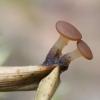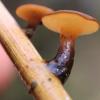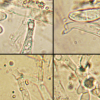
14-06-2019 06:40
 Django Grootmyers
Django Grootmyers
What is this parasite of Cantharellus minor? Found

11-06-2019 01:49
Valencia Lopez Francisco JavierHola amigos...Adjunto fotos de unas supuestas Para

11-06-2019 00:32
Elisabeth StöckliBonsoir, Sur feuilles de ronce (Rubus/roncier à

11-06-2019 16:20
Garcia SusanaHola, He recolectado este asco sobre estiercol, c

12-06-2019 22:42
Ethan CrensonHello all, A friend noticed these tiny fruiting b

11-06-2019 00:08
Ethan CrensonHello all, I found a few of these tiny black cush
Separate Rutstroemia henningsiana from Rutstroemia paludosa
Jan-Arne Mentken,
02-05-2017 15:47
some days ago I found a Rutstroemia on Juncus. Thanks to former thread in this forum I was able to exclude Rutstromia calopus (no croziers / substrate).
Nevertheless also the German main page for fungi mapping as well as Index Fungorum list R. henningsiana and R. paludosa as individual species. Does anyone know how to separate them from each other? I was looking for literature, but didn't find too much. CASH & DAVIDSON (1961) say that the spores of R. paludosa are 12-14 µm long and the asci around 150 µm. Compared to that, SACCARDO & SYDOW (1902) made an early description and characterized Ciboria henningsiana with spores of 15-18 µm and asci with 160-200 µm length. I'm not sure how to assess these information though. Can anyone help?
Kind regards,
Jan-Arne
Hans-Otto Baral,
02-05-2017 16:07

Re : Separate Rutstroemia henningsiana from Rutstroemia paludosa
Hin Jan-Arne
In my experience there is no difference in ascus and spore size. 160-200 µm could mean that the asci were alive, which easily results in 150 µm when dead.
The only difference I know is croziers absent or present:
C. paludosa/henningsiana on Cyperaceae & Juncaceae, H-
C. calopus on Poaceae H+
maybe you confused the downward protuberance as a crozier?
Zotto
In my experience there is no difference in ascus and spore size. 160-200 µm could mean that the asci were alive, which easily results in 150 µm when dead.
The only difference I know is croziers absent or present:
C. paludosa/henningsiana on Cyperaceae & Juncaceae, H-
C. calopus on Poaceae H+
maybe you confused the downward protuberance as a crozier?
Zotto
Jan-Arne Mentken,
02-05-2017 16:15
Re : Separate Rutstroemia henningsiana from Rutstroemia paludosa
Hi Zotto,
thank you for the fast response and sorry. I didn't express myself correctly. There were no croziers. That is why I was able to exclude R. calopus yet. Now I want to know the correct name. Index Fungorum just like Pilze-Deutschland splits R. paludosa and R. henningsiana into two species instead of seeing them as synonyms. Is that a mistake? Because if not, I would still like to get to a name for my collection by knowing how to differentiate these two.
Liebe Grüße
Jan-Arne
thank you for the fast response and sorry. I didn't express myself correctly. There were no croziers. That is why I was able to exclude R. calopus yet. Now I want to know the correct name. Index Fungorum just like Pilze-Deutschland splits R. paludosa and R. henningsiana into two species instead of seeing them as synonyms. Is that a mistake? Because if not, I would still like to get to a name for my collection by knowing how to differentiate these two.
Liebe Grüße
Jan-Arne
Jan-Arne Mentken,
02-05-2017 19:54
Hans-Otto Baral,
02-05-2017 20:36

Re : Separate Rutstroemia henningsiana from Rutstroemia paludosa
It is just what I meant: Simple septa with basal protuberances that do not fuse with the cell below.
Jan-Arne Mentken,
03-05-2017 06:39
Re : Separate Rutstroemia henningsiana from Rutstroemia paludosa
Oh well. I fell for it even with an explicit warning in advance. Okay then. I will call my fungi R. paludosa/R. henningsiana without knowing if any precise distinction is possible. Thank you, Zotto!
Hans-Otto Baral,
03-05-2017 09:04

Re : Separate Rutstroemia henningsiana from Rutstroemia paludosa
The distinction is actually precise and so far quite consistent over many collections. The problem is mainly that this character was neglected over decades. The same happened with Hymenoscyphus albidus/fraxineus, which were treated as "cryptic species" because most workers were unable to evaliuate the feature. So these species were only distinguished by DNA although I could say what it is only with the microscope.
The identity of R. calopus/paludosa/henningsiana remains to be checked from the type specimens, I only rely on their identity based on the substrate.
Zotto
The identity of R. calopus/paludosa/henningsiana remains to be checked from the type specimens, I only rely on their identity based on the substrate.
Zotto




